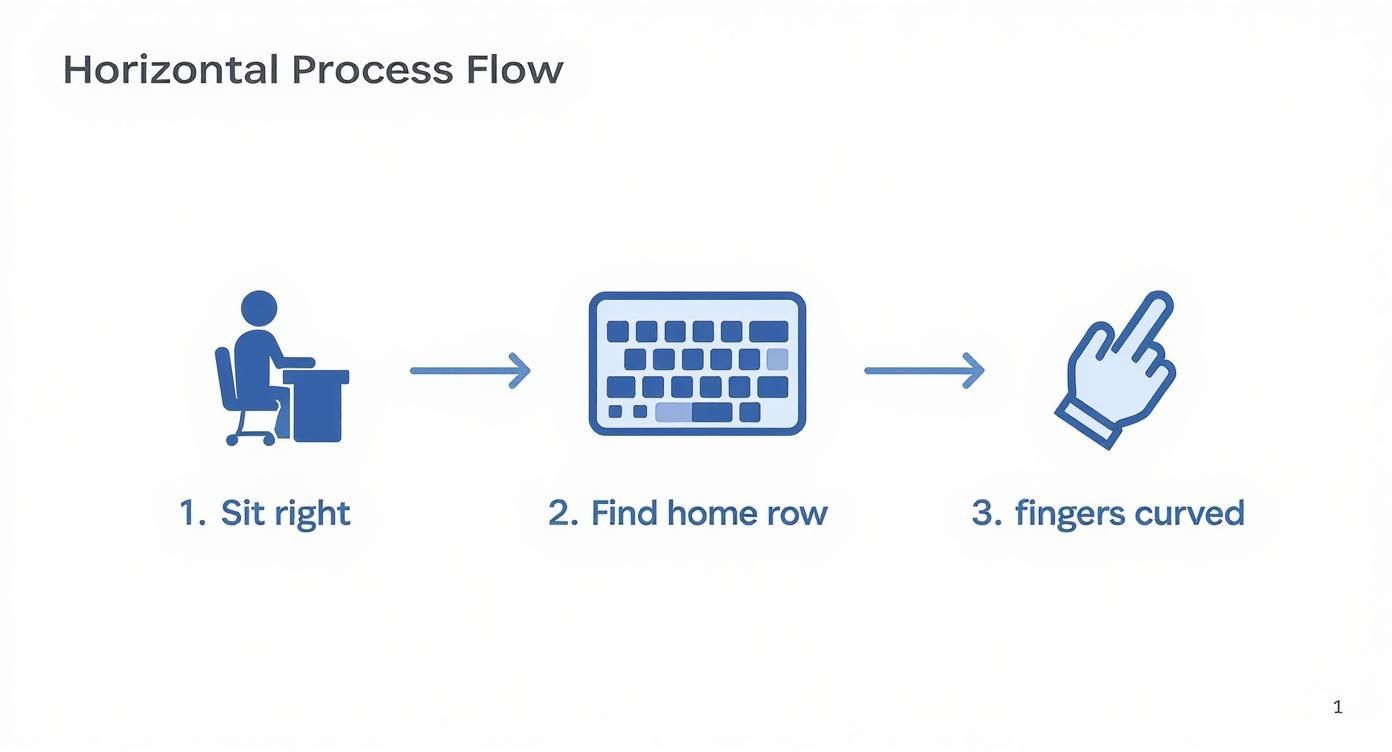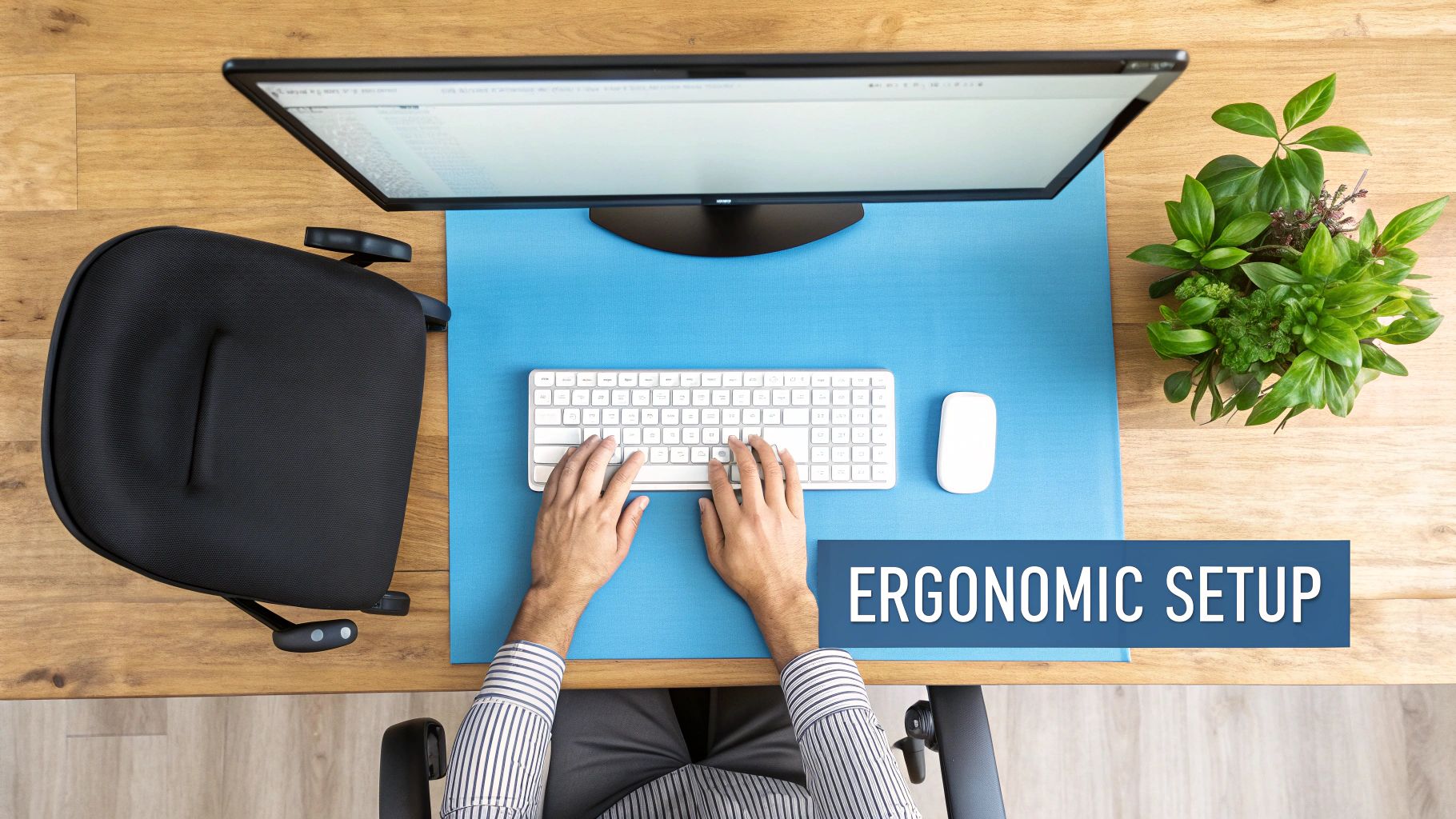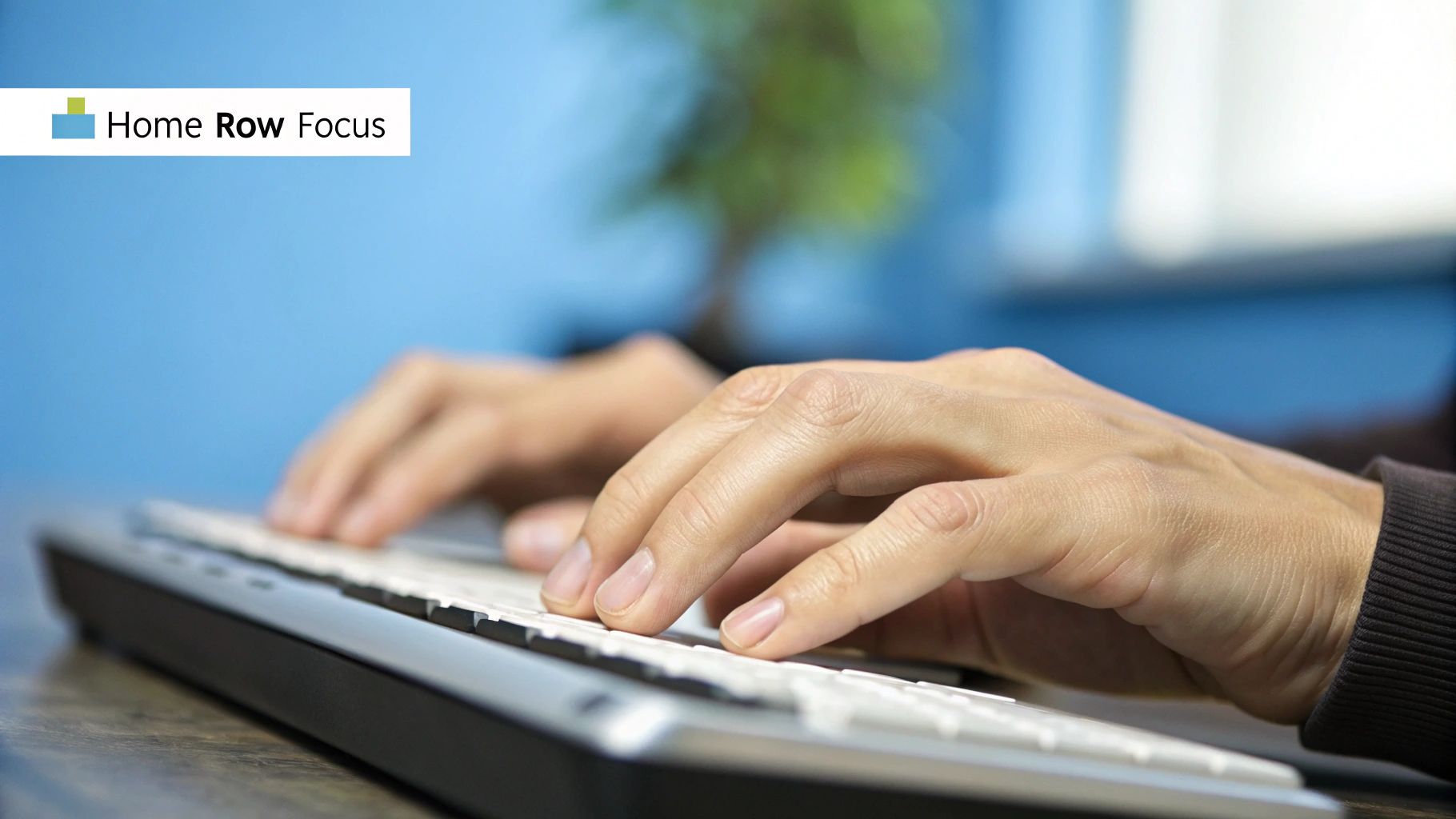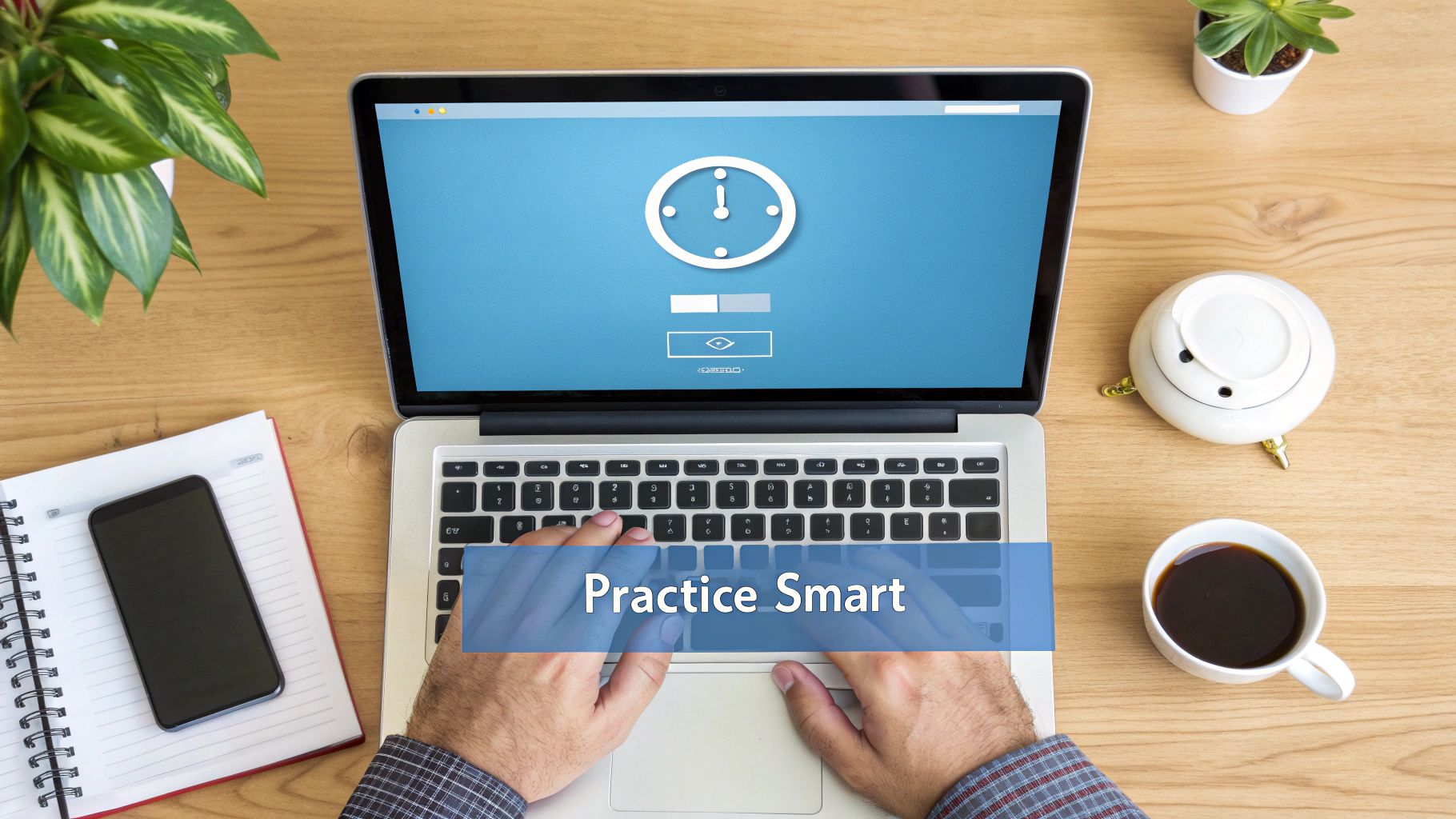Do you want to type super fast? It's not a big secret trick. It's about two easy things: sitting the right way and teaching your fingers where to go so you don't have to look for letters.
Doing these simple things is the best way to get faster. Soon, you'll be typing more words every minute without even trying hard.
Get Ready to Type Fast
Before you can type like a flash, you need to set up your space. Think of it like building a big tower with blocks. You need a strong bottom so it won't fall over. For typing, how you sit and where you put your hands is your strong bottom. Most people forget this, but it's what slows them down.
If you sit wrong, you don't just feel sore. It makes you slow because your back, wrists, and fingers get tired. We will fix that with some easy changes that will help you for a long, long time.
Sit Right to Go Faster
Your body is your best tool for typing, so let's put it in the right spot. If you are bent over your desk, your arms and hands get tired really fast.
The goal is to sit in a comfy way that you can keep doing. Sit up straight with your feet on the floor. Your elbows should make an 'L' shape, like a corner. This helps your blood move and stops your muscles from hurting. This lets you type for a long time without feeling tired.
We all bend over our keyboards sometimes. But sitting up straight is one of the best and easiest things you can do to type faster. Here are some quick fixes that help.
Easy Ways to Sit for Speed
| Body Part | What to Do | How It Helps You Go Fast |
|---|---|---|
| Back | Sit straight. Your lower back should feel supported. | You get less tired, so you can type for longer without stopping. |
| Feet | Put them flat on the floor or on a little stool. | This keeps your body steady so you don't wiggle and waste energy. |
| Elbows | Bend them like an 'L' shape, close to your body. | This lets your fingers move easily and quickly. |
| Wrists | Keep them straight, not bent up or down. | This stops them from hurting and lets your fingers move freely. |
Making these small changes makes typing easier on your body. This lets your brain think about the words you want to type.
Find the Starting Spot for Your Fingers
Every keyboard has a home for your fingers. It's called the home row. This is the middle row of letters: ASDF for your left hand and JKL; for your right. You don't have to look to find it. Feel for the little bumps on the 'F' and 'J' keys. Those are your guides.
Your fingers should always start on the home row. After you press any other key, they should go right back. This is the most important habit to learn so you don't have to look at your keyboard.
This is what touch typing is all about. Soon, your fingers will remember where to go all by themselves.


Sitting right and putting your hands in the right place work together. They make it feel easy to type fast.
Once you have the body part down, you can work on the brain part. These tips help your fingers go fast. You can also read our guide on how to improve writing speed to help get your ideas on the page faster. When your fingers can keep up with your brain, writing feels much easier.
Learn the Keyboard Without Looking
The one thing that slows you down the most is looking at your hands. I see it all the time. Stopping this habit is like taking the training wheels off a bike. It feels wobbly at first, but it's the only way to go fast. The goal is easy: teach your fingers where every key is, so your eyes don't have to help. This is called muscle memory.
Think about how you learned to walk. You didn't look at your feet for every step. After a while, your legs just knew what to do. That's what we want for your fingers. Once they know the keyboard by heart, you can just look at the screen and watch your words show up.


Give Every Finger a Job
The trick to typing well is not just about moving fast. It's about teamwork. Each of your fingers should be in charge of its own set of keys. This is much better than "hunt-and-peck" typing, where one or two fingers do all the work.
Imagine a soccer team where only one person runs around the field. It would not work well. Typing is the same. When each finger has its own area, your hands don't have to move much at all.
- Pointer Fingers: They are the busiest fingers. They press the keys in the middle, like R, F, V, U, J, and M.
- Middle Fingers: They press the keys right above and below them, like E, D, C and I, K, <.
- Ring Fingers: Your ring fingers take care of letters like W, S, X and O, L, >.
- Little Fingers: Your pinkies are important! They might feel small, but they press the keys on the outside edges, like Q, A, Z, P, ;, /, plus the big Shift and Enter keys.
When each finger has a job, you don't waste any movement. This helps you type in a smooth, easy way.
Make Practice Fun with Games
Let's be real, practice can be boring. But you don't have to type "the quick brown fox" again and again. Lots of websites turn typing practice into a game. You can race cars or pop balloons just by typing the right letters.
This makes learning feel like playing. When you have fun, you want to keep doing it. These games are made to make you use the right fingers over and over until you don't have to think about it anymore.
The real goal is not just to be fast. The goal is to be right. Speed comes after you get good at hitting the right key with the right finger. When you do that, you will get faster without even trying.
How Fast Should You Be?
It helps to have a goal. Typing is a very important skill. People who type for their jobs used to try for 60 to 90 words per minute (WPM). Today, a normal person types about 52 WPM on a computer. That number goes down to 38 WPM on a phone. This shows how much a real keyboard helps.
Want to see how you are doing? You can find more typing speed statistics to check your score. By teaching your fingers and not looking down, you are learning the most important thing for fast typing.
Practice Smarter, Not Just More


Just typing for many hours won't make you faster if you are still doing it the wrong way. It's like trying to get better at basketball by shooting with your eyes closed. You are practicing, but not getting better. The real way to get faster is to practice the right way.
Here is a secret: have different goals on different days. Some days, just try to be perfect. Type every letter right, even if it feels very slow. On other days, try to go as fast as you can. It's okay to make a few mistakes. This mix of careful days and fast days is the key to getting much faster.
First, Get It Right
When you start, forget about being fast. Your only job is to be right. Think of it like learning a new song on a piano. You have to hit the right notes slowly first. Then you can play it fast.
Every time you hit the backspace key, you are not just fixing a mistake. You are stopping your flow and wasting time. When you try to get every letter right the first time, you teach your fingers where to go. Speed will come later, after your fingers know the way.
This is true! A study of many students showed that people who typed under 30 WPM were the most accurate, with 97.2% of letters correct. You can look at the full typing proficiency data if you want. The lesson is clear: being right is the first step to being fast.
Then, Push for Speed
After you have spent time being careful and right, it's time to change. Now, you will practice just for speed. The goal is to make your fingers move a little faster than what feels normal.
Don't worry if you make more mistakes when you do this. That's supposed to happen! You are teaching your hands and brain to go past their old speed limit. By trying to go faster, you show yourself that you can.
Doing both is super important. Being right builds a strong base. Pushing for speed makes you even faster. You need both to be a really fast typist.
Make Practice Fun (and Useful)
Let's be honest, typing drills are boring. The good news is you don't have to type silly words again and again. You can make practice a lot more fun.
Play Typing Games: Lots of free websites turn typing into a game. You can race cars or zap aliens with your keyboard. It makes work feel like play.
Type Things You Like: Pick something you want to read or remember. Try typing the words to your favorite song, a line from a movie, or a page from a book you are reading.
This last tip is a great one because you practice typing real sentences, with periods and capital letters. When you like your practice, you will do it more often. And that is how you will see a big change in your speed.
Pro Tricks for Top Typing Speed


You have worked hard and learned the basics. Now, let's learn the real secrets that make good typists great. These tricks are not just about hitting keys faster. They are about thinking about the keyboard in a new way.
The biggest change is to stop seeing single letters. Instead, teach your brain to see whole words at once. When you read the word "example," your brain sees the whole word right away. It doesn't read e-x-a-m-p-l-e. The fastest typists do this with their fingers. Their fingers type common words in one smooth motion.
When you switch from typing letters to typing words, you will really feel yourself get faster and smoother.
Find Your Typing Beat
One thing great typists have is a good rhythm. They type with a steady beat, like a drummer playing music. A smooth, even speed is much better than typing fast for a second and then stopping.
It's like tapping your fingers on a table. A choppy, uneven tap is slow and clumsy. But a steady, even beat feels fast and easy. You want to find that same feeling when you type.
A steady beat is the best way to stop getting "stuck" between words. It helps you keep going, which is how you get past your old speed limit and set a new record.
This steady beat not only makes you faster, but it also helps you make fewer mistakes.
Try a Different Keyboard Style
Most people in the world use a QWERTY keyboard. We use it so much we don't think about it. But here's a secret: it was not made to be fast. It was made to stop the metal arms on old typewriters from getting stuck together.
Many of the world's fastest typists use other keyboards, like the Dvorak keyboard. The Dvorak keyboard is smart because it puts the letters we use the most on the home row, right where your fingers rest. This means your fingers don't have to travel as far to type common words.
Changing to a new keyboard is a big deal, but for some people, it helps them type faster than ever before. How fast? A pro typist might aim for 70-80 WPM, but some people are much faster. Using a Dvorak keyboard, a woman named Barbara Blackburn typed 150 WPM for 50 minutes straight. You can check out more of the world's fastest typing records to see what people can do.
Learning these pro tricks will make your typing skills amazing. When you can get your thoughts on the screen this fast, you'll know how to increase productivity in everything you do, not just typing.
Give Your Fingers a Break and Use Your Voice
https://www.youtube.com/embed/QAb3ATOpBpE
Getting faster at typing is great, but even the best typists get tired. Sometimes, the best way to get your thoughts on the screen is not with your fingers. It's by talking.
Think about when you have lots of ideas. They can pop into your head so fast that even a super-fast typist can't keep up. This is a good time to use your voice as a secret weapon.
You can just talk, and let all your ideas come out without stopping to type. It's like talking to your computer. This isn't about giving up on your typing skills. It's about having another great tool to help you get work done.
Let Your Voice Do the First Part
New voice-to-text tools are really good. They listen to what you say and type it for you. Imagine you have a big paper to write. Instead of staring at the screen, you could walk around and just say what you want to write. This helps you get your ideas down without worrying if every word is perfect.
Once your ideas are on the page, you can go back and use your great typing skills to fix them up. This two-step plan—talk first, type second—can feel more fun and helps you not get stuck.
This is a really good idea when you feel:
- Tired: Your brain might be full of ideas, but your hands are tired.
- Stuck: Talking can feel more natural than typing and can help your ideas flow.
- Like you have too much to do: It's a great way to get a lot of thoughts on the page very fast.
Using your voice to get ideas out and your keyboard to clean them up is just a smart way to work. You can learn more about how new voice-to-text software can help you every day.
Protect Your Best Tools
Giving your fingers a rest is important to stay healthy, but that's not all. Staring at a screen for a long time can make your eyes tired. When your eyes are tired, it's harder to focus and type without mistakes.
Taking breaks for your hands and eyes is not just a nice thing to do. It's a key way to stay fast and get your work done for a long time. Taking care of yourself helps you do your best work.
Besides resting your fingers, you have to take care of your eyes. For some great tips, check out a practical guide on how to reduce eye strain. By taking care of your whole body, you are setting yourself up to keep typing super fast.
Got Questions About Typing Faster? We've Got Answers.
When you decide to get better at typing, you might have some questions. It's a real skill. Learning the right answers from the start can save you from getting frustrated. Let's talk about some common questions.
A big one is, "How long will this take?" The real answer is, it's different for everyone. It's not about how many hours you practice, but how you practice. Think of it like learning to play an instrument. Some people learn faster than others.
But, if you can practice for 30 minutes a day, you will be surprised how much better you can get in just a few months. Practicing a little bit every day is better than practicing a lot on one day.
Is It Too Late to Stop My Bad Typing Habits?
No way. I hear this all the time from people who have been typing with just one or two fingers for years. Your brain is very good at learning new things. You can teach your fingers a new way to type, no matter how old you are.
It will feel weird at first, like trying to write with your other hand. Your old habits will try to come back, especially when you are in a hurry. But every time you put your fingers back on the home row and use the right finger, you are making a new, faster path in your brain.
Here's a pro tip: Don't try to fix everything at once. Pick one small thing to work on. For the first week, just focus on keeping your fingers on the home row. That's it. Then add something new.
What's a Good Typing Speed to Have as a Goal?
This is a great question because it gives you something to work toward. What is "fast" can be different for everyone. But we can look at some common scores to give you a goal.
Here is a guide to what different speeds mean:
- Average Speed: Most people type around 40-50 words per minute (WPM). This is good for sending emails and other daily tasks.
- Good Speed: Getting to 60 WPM is a great goal. At this speed, your typing is fast enough to keep up with your thoughts.
- Professional Speed: People who type a lot for their jobs often hit 80 WPM or more. This is so fast it feels like your thoughts are just showing up on the screen.
And please, don't feel bad if you test yourself and you are at 20 WPM. Getting better is about small wins. Seeing your score go from 20 to 25 WPM is a big deal! It shows that what you are doing is working.
When your fingers are tired but you still have work to do, it's time for a new tool. WriteVoice lets you keep working without stopping. Just talk, and your words show up on the screen in any app—up to four times faster than typing. It’s great for getting ideas down or just giving your hands a rest. Give it a try for free at https://www.writevoice.io.
